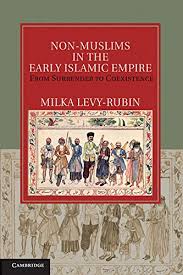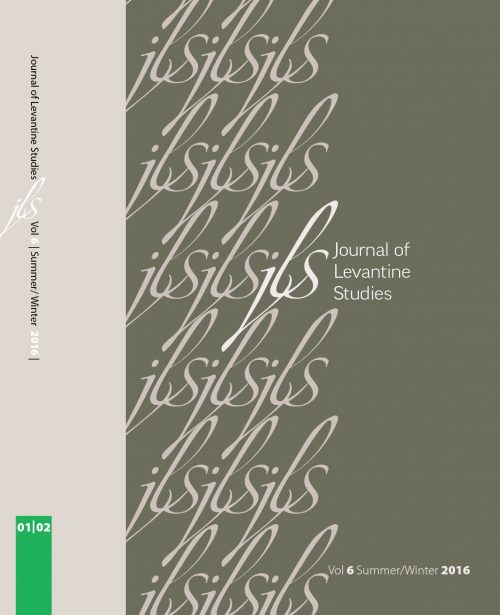-
Add to cartQuick view
Musicians between the Hegemonies
Inbal Perlson
$5.00Free!Add to cartQuick view -
Add to cartQuick view
Musicians between the Hegemonies: A Response
Martin Stokes
$5.00Free!Add to cartQuick view -
Add to cartQuick view
Review Essay: Minorities and Majorities: The Nation-State and Identitarian Politics in the Modern Levant
Free!Kais M. Firro, Metamorphosis of the Nation (al-Umma): The Rise of Arabism and Minorities in Syria and Lebanon, 1850–1940. Brighton; Portland, OR: Sussex Academic Press, 2009. 201 pp.Benjamin Thomas White, The Emergence of Minorities in the Middle East: The Politics of Community in French Mandate Syria. Edinburgh: Edinburgh University Press, 2011. 239 pp.Add to cartQuick view -
Add to cartQuick view
Review Essay: The Transforming Landscape of Turkey’s Alevi Politics
Free!Review Essay:
Elise Massicard, The Alevis in Turkey and Europe: Identity and Managing Territorial Diversity. New York: Routledge, 2013. 255 pp.Necdet Subaşı, Alevi Modernleşmesi: Sırrı Faş Eylemek. İstanbul: Timaş, 2008. 320 pp.Add to cartQuick view -
Add to cartQuick view
The Making of Palestinian Christian Womanhood: Gender, Class, and Community in Mandate Palestine
This article seeks to expand the study of Palestinian Arab women’s self-identification and social and political activism by examining how Arab Christian women viewed, shaped, and managed their participation in the project of defining Palestinian national identity during the period of British colonial occupation. During the Mandate period, elite Christian women made particular use of mission schools and Christian women’s charitable organizations as platforms for promoting a vision of Palestinian nationalism as modern, nonsectarian, and politically progressive, in hopes of creating a Palestinian national identity in which they could claim a central role. As the Mandate wore on, though, it became increasingly evident that the presentation of Christian women as central to the expression of a broadly based, nonsectarian, modernizing, Westernizing Palestinian national identity was belied somewhat by the communal and class consciousness that education in elite Christian schools and membership in charitable organizations engendered. The way in which this purportedly middle-class, nonsectarian nationalist vision was developed and articulated in highly class- and communally conscious venues ultimately limited its purview and linked it with oppressive colonial practices in the eyes of much of the Palestinian Arab population.
$5.00Free!Add to cartQuick view -
 Add to cartQuick view
Add to cartQuick viewBetween Politics and Politics of Identity: The Case of the Arab Jews
Free!The article introduces the term “political Arab Jew,” its nature and meaning. It will show that proponents of the Arab Jew seek to separate the ethnic from the national, the Jew from the Zionist, and realign ethnic identities: Arabs, who include Jews and Muslims, vs. Ashkenazim/Zionists. They do so by creating an “imagined community,” by rejecting an ascriptive identity based on an ethnic/national juxtaposition, and by suggesting their own kind of identity, a self-ascriptive identity that separates the ethnos from the nation. They have failed in their mission, as the majority of Jews of Middle Eastern and North African origin reject the Arab Jew definer as representing their own identity. Even the more militant Mizrahim, who are fighting to change Mizrahi-Ashkenazi relations, limit their activities to the cultural field; when their goal is to redefine the place of the Mizrahim in Israel, they do so from within, not outside of, Jewish/Zionist society.
Add to cartQuick view -
Add to cartQuick view
Milka Levy-Rubin, Non-Muslims in the Early Islamic Empire: From Surrender to Coexistence. Cambridge: Cambridge University Press, 2011. 267 pp.
Milka Levy-Rubin, Non-Muslims in the Early Islamic Empire: From Surrender to Coexistence. Cambridge: Cambridge University Press, 2011. 267 pp.
$5.00Free!Add to cartQuick view -
Add to cartQuick view
The Palestinian Historiography of Family Leadership during the British Mandate
Free!This article seeks to expand the study of Palestinian Arab women’s self-identification and social and political activism by examining how Arab Christian women viewed, shaped, and managed their participation in the project of defining Palestinian national identity during the period of British colonial occupation. During the Mandate period, elite Christian women made particular use of mission schools and Christian women’s charitable organizations as platforms for promoting a vision of Palestinian nationalism as modern, nonsectarian, and politically progressive, in hopes of creating a Palestinian national identity in which they could claim a central role. As the Mandate wore on, though, it became increasingly evident that the presentation of Christian women as central to the expression of a broadly based, nonsectarian, modernizing, Westernizing Palestinian national identity was belied somewhat by the communal and class consciousness that education in elite Christian schools and membership in charitable organizations engendered. The way in which this purportedly middle-class, nonsectarian nationalist vision was developed and articulated in highly class- and communally conscious venues ultimately limited its purview and linked it with oppressive colonial practices in the eyes of much of the Palestinian Arab population.
Add to cartQuick view -
 Add to cartQuick view
Add to cartQuick viewThe Arab Jew Debates: Media, Culture, Politics, History
For the past twenty-five years, and particularly during the last decade, the idea of the Arab Jew has been debated in multiple forums in different parts of the world. The Arab Jew is represented in literature and film, discussed in blogs and social media, and featured in live performances. It has informed scholarship in literary and cultural studies, sociology, and history, in Israel, the Arab world, Europe, and North America. Yet the term “Arab Jew” remains controversial, especially in Israel, where it is widely viewed as a left-wing political concept. This article surveys the Arab Jew’s full range of expression to date, emphasizing the reciprocal movement of ideas across different geographies and between discursive spheres. It argues that the Arab Jew idea has developed as both a project of political intervention into the present-day separation of Arabness from Jewishness and a project of reconstruction focusing on the Jewish past in the MENA region. Examining recent episodes in the Israeli public sphere, the article investigates how contemporary discussions about Arab Jewish identity and culture utilize competing views of history. It concludes by reconsidering the relevance of the “Arab Jew” to the burgeoning historical scholarship on Jews in the MENA region during the nineteenth and twentieth centuries.
$5.00Free!Add to cartQuick view -
 Add to cartQuick view
Add to cartQuick viewAbandoning Language: The Project of Arab-Jewish Subjectivity in Sami Michael’s Arabic Fiction of the 1950s
Free!Sami Michael is a well-known, Iraqi-born Israeli writer whose best-selling works have been widely discussed in both public and academic discourse. However, long before writing in Hebrew, Michael published several short stories and articles in his native Arabic during the 1950s. This article examines a selection of Michael’s Arabic stories and frames them as the genesis of his representations of Arab-Jewish subjectivity, while also emphasizing the importance of the fact that a well-known Israeli writer began his literary career in Arabic. I argue that to sketch out a fuller picture of Michael’s literary voice, we must take into account the ways in which his early Arabic writings were precursors of his later Hebrew novels and how the process of abandoning his native language was formative even before his switch to Hebrew. The short stories discussed here all confront the ambivalences and, importantly, the possibilities that characterize Michael’s imagined Arab-Jewish subjectivity, suggesting it to be a literary sensibility fraught with a paradoxical sense of simultaneous potential and dissolution.
Add to cartQuick view -
 Add to cartQuick view
Add to cartQuick viewWe can’t understand ourselves without the Arabic: Dreams in Cambridge (2009)
In this paper I discuss the question of Jewish-Arab identity, its intergenerational differences, its different definitions in Hebrew and Arabic, and the differences in its usage in modern times and earlier periods. In Jewish-Arab identity, as in every identity, there is a mixture of self-identification and outer-identification. Whatever one’s reason for identifying as an Arab-Jew—whether related to the historical and cultural background or because one’s family identified this way prior to Zionism and immigration or in defiance of today’s national identities in Israel and the Arab world—it does not “have” to create as strong an objection as it does. However, the objection is understood when it is an outer-identification that flattens differences between historical periods, regions, or differences between the Jews of the Muslim world. In the late nineteenth century, Jewish-Arab identity was an identification with the Nahḍa movement, with the awakening of Arabic literature and language, and it sought to reweave Jewish-Arab identity, written culture, and memory into the Arab revival, or at least into the Arab literary imagination. Later, in the first half of the twentieth century, Jewish-Arab identity was an identification with local Arab nationalism in the different Arab lands, seen as a potential for a large-scale project, started by the intellectual elite, that would make Jews an integral and equal part of their societies. In the second half of the twentieth century, after 1948 and after immigration, mostly to Israel, Jewish-Arab identity was an identity that expressed criticism of both national projects, Jewish and Arab, their marginalization and nonacceptance of the Arab-Jews, and their exclusive and oppressive nature.
$5.00Free!Add to cartQuick view -
Add to cartQuick view
Papal Bulls and Converso Brokers: New Christian Agents at the Service of the Catholic Monarchy in the Roman Curia (1550-1650)
Free!This paper analyzes the presence of the New Christian minority within the system of curial agencies, a key structure for the interests of the Catholic monarchy in Rome. It was a stable network of agents that reflected the multiplicity of territories under the sovereignty of the Spanish Habsburgs and worked alongside the Spanish embassy to the Holy See. Factors explaining the significant converso presence and the curial dynamics behind the creation of the system of agencies are examined, illustrating the operation thereof through various case studies, with special attention to Portugal’s agency. A transversal approach is employed in the study of this system, which has been very poorly understood until now.
Add to cartQuick view
- Home
- About JLS
- Issues
- Vol. 9 No. 1 | Summer 2019
- Vol 8 No 2 Winter 2018
- Vol. 8, No. 1: Summer 2018
- Vol. 7, No. 2: Winter 2017
- Vol. 7, 1: Summer 2017
- Vol. 6, Summer/Winter 2016
- Vol. 5, No. 2 Winter 2015
- Vol. 5, No. 1 Summer 2015
- Vol. 4, No. 2 Winter 2014
- Vol. 4, No. 1 Summer 2014
- Vol. 3, No. 2 Winter 2013
- Vol. 3, No. 1 Summer 2013
- Vol. 2, No. 2 Winter 2012
- Vol. 2, No. 1 Summer 2012
- Vol. 1, No. 2 Winter 2011
- Vol. 1, No. 1 Summer 2011
- Blog
- dock-uments
- Subscribe
- Submit
- Contact



